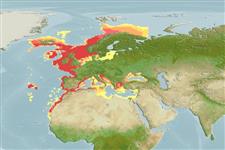Preferred temperature (Ref.
123201): 6.9 - 15.4, mean 10.2 °C (based on 672 cells).
Fylogenetische diversiteitsindex (Ref.
82804): PD
50 = 0.5000 [Uniqueness, from 0.5 = low to 2.0 = high].
Bayesian length-weight: a=0.00468 (0.00421 - 0.00519), b=3.12 (3.09 - 3.15), in cm total length, based on LWR estimates for this species (Ref.
93245).
Trofisch niveau (Ref.
69278): 4.4 ±0.0 se; based on diet studies.
Generation time: 9.2 (8.5 - 10.4) years. Estimated as median ln(3)/K based on 92
growth studies.
Weerstandsvermogen (Ref.
120179): Gemiddeld, minimale populatieverdubbelingstijd 1,4-4,4 jaar (K=0.1; tm=3, tmax=20; Fecundity=7 million).
Prior r = 0.48, 95% CL = 0.32 - 0.72, Based on 34 full stock assessments.
Fishing Vulnerability (Ref.
59153): High vulnerability (65 of 100).
🛈
Climate Vulnerability (Ref.
125649): Moderate vulnerability (39 of 100).
🛈
Nutrients (Ref.
124155): Calcium = 8.42 [4.50, 24.86] mg/100g; Iron = 0.22 [0.08, 0.52] mg/100g; Protein = 17.7 [16.7, 18.7] %; Omega3 = 0.248 [0.172, 0.355] g/100g; Selenium = 34.6 [19.1, 64.2] μg/100g; VitaminA = 11.8 [3.4, 39.2] μg/100g; Zinc = 0.246 [0.175, 0.341] mg/100g (wet weight); based on
nutrient studies. 